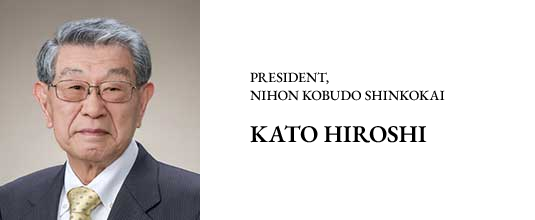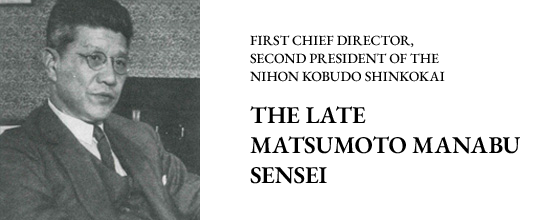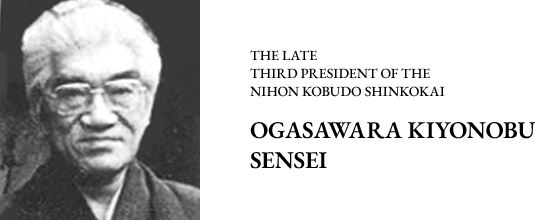Kobudo(classical budo), handed down for hundreds of years to this day, are practical martial arts attained by the men of old through battles where life and death were at stake.
Cultivated by a beauty comprising technical and mental methodologies, as well as the samurai's honorable creeds of benevolence, righteousness, courtesy, wisdom, and fidelity, Kobudo is one of Japan's proudest traditional cultural assets.
Kobudo has made great contributions to Japanese culture through Kabuki, theater, cinema, literature, and art, even influencing the Japanese language. It is truly a representational culture of Japan transcending time and space.
The Nihon Kobudo Shinkokai is the oldest organization of Kobudo schools, formed in 1935 by the representatives of the various Kobudo schools and knowledgeable people of that time, such as Justice Minister Matsukichi Koyama, after House of Peers member Manabu Matsumoto advocated to preserve and promote Kobudo as a valuable cultural heritage to be proud of. Currently, our society of about 90 schools and 1,000 members strives to preserve and promote Kobudo, holding demonstrations throughout Japan every year.
I would like to further study this valuable traditional culture of Kobudo, and continue to share it not only with Japan but also with the world.
TOP / ABOUT US
Greetings

The Last Instructions

It is said that bu (martial arts) should be kept within and not shown to the outside world.
The goal of the Nihon Kobudo Shinkokai is to give meaning to our daily lives with a humble heart, using our serious daily training as food for our souls.
The Kobudo, which were developed as techniques and tools for battle, were further refined during 300 years of peace during the Tokugawa era, becoming integrated not only into martial arts but also our culture and rules for daily life.
Its mindset and posture have been used as a model of daily behavior in formal etiquette as well as Noh and the performing arts. It would be an irreparable regret if Kobudo, the origin of various cultural heritages passed down to the present day, were to di e out.
It is my earnest hope that every one of you will continue to devote yourself to the precious traditions of Kobudo, into which the founders of each school and tradition poured their hearts and souls to realize, and handed down perfectly as if from one vesse l to another.
At the same time, as I mentioned earlier, I would like to ask for your efforts and dedication to applying the essence of Kobudo to modern society and daily life. Likewise, I hope that young people will be educated in true martial arts so that the spirit of classical martial arts can be kept alive in the hearts of the Japanese people.
Dedication to Matsumoto Manabu Sensei on the occasion of the publication of "Shinei" (separate)

The Nihon Kobudo Shinkokai was established in February 1935 at the suggestion of the late Manabu Matsumoto and was approved as an incorporated foundation on April 4, 1940. We have continued various activities such as Kobudo(classical budo) demonstrations, instructor training cours es, and Kobudo exhibitions. Although temporarily suspended due to the Greater East Asian War, activities were resumed after the war and continue to this day. Currently, with the participation of many schools, we hold many meaningf ul events in the year, centering on the November 3rd dedicatory demonstration at Meiji Grand Shrine, and including dedications to Ise Grand Shrine, Kamo Shrine, Atsuta Grand Shrine, and others, as well as many other shrines where dedications have been cust omary since before the war. In addition, as part of the activities of the Nihon Kobudo Shinkokai , we have published three issues of the bulletin "At the same, it can be said that interest in Kobudo is a trend in many fields and that many organizations, including the Budokan, have been paying attention to Kobudo and showing a deepening interest in the signs of its revival.
This is a great thing for Kobudo, but I do not think that there are that many people who love Kobudo, have a deep understanding of it, and can truly examine its future course based on their own experience. Considering this situation, I have high hopes for the future of the Soke, Shihan, and all those involved, who have a deep understanding of the significance of preserving these traditions as part of Japanese culture. In this sense, the members of the Kobudo Promotion Society are people important to Japan. To protect and promote this precious folk culture of Japan along with all of you, I would like to come together in this Nihon Kobudo Shinkokai and hope for the further development and prosperity of this society. Shinei's separate volume has been issued with this meaning in mind.
November 3, 1980
Successive Presidents
| The 1st President | Oyama Matsukichi |
|---|---|
| The 2nd President | Matsumoto Manbabu (a member of the House of Lords) |
| The 3rd President | Ogasawara Kiyonobu (Ogasawara ryū Kyūba jutsu Reihō) |
| The 4th President | Kato Takashi (Tatsumi ryū) |
| The 5th President | Saito Satoshi (Negishi ryū Shuriken jutsu) |
| The 6th President | Iizasa Yasusada (Tenshinshō den Katori Shintō ryū Hyōhō) |
| The 7th President | Ogasawara Kiyotada (Ogasawara ryū Kyūba jutsu Reihō) |
| The 8th President | Kato Hiroshi (Tatsumi ryū) |
The Nihon Kobudou Shinkokai board members
| The President | Kato Hiroshi (Tatsumi ryū) |
|---|---|
| The Vice President | Yagyu Koichi (Yagyu Shinkage Ryu Heiho, Yagyu Seigo Ryu Batto) |
| The Vice President | Kimura Yasuko (Tendō ryū) |
| The Secretary General | Shibata Akio (Kurama ryū Kenjutsu) |
| The Executive Director | Usami Yuji (Sōsuishi ryū Kogusoku Koshinomawari Kumiuchi) Ogawa Takeshi (Shindō Munen ryū Kenjutsu, Musō Shinden ryū Battōjutsu) Kondo Katsuyuki (in cha rge of examination) (Daito ryū Aiki Jūjutsu) Tsumaki Tatsuo (Tamiya ryū Iaijutsu) Morimoto Kunio (in charge of examination)(Musō Shinden Eishin ryū Battō Heihō,Shibukawa Ichi ryū Jūjutsu) Yoshikawa Tsunetaka (Kashima Shito ryū Kenjutsu) |
| The Treasurer Director | Esumi Kazutoshi (Shintō Musō ryū Jōjutsu) |
| The Cash Auditor Director | Nemoto Kenichi (Muhi Muteki ryū Jōjutsu Igaryūha Katsu Shin ryū Jūjutsu) |
| The Director | Otsuka Hiroki (Wadō ryū Jūjutsu Kempō Karate jutsu) Suzuki Yukiko (Ono ha Itto ryū Kenjutsu, Shin Musō Hayashizaki ryū Iaijutsu, Chokugen ryū Ōnaginatajutsu) Sobue Mitsunori(Sekiguchi ryū Battō jutsu) Takenouchi Toichiro (Takenouchi ryū Koshinomawari Kogusoku) Tomabechi Yoshimi (Negishi ryū Shuriken jutsu, Shirai ryū Shuriken jutsu) Mizushina tsunemi (Kiraku ryū Jūjutsu) |
| The Auditor | Chiba Akira (Araki ryū Gunyō Kogusoku) |
| The Councilor | Iizasa Yasusada (Tenshinshō den Katori Shintō ryū Hyōhō) Ogasawara KIyotada (Ogasawara ryū Kyūba jutsu Reihō) |
You can email us at info@kobudhin.jp about the general matter.
Please ask the representative members of each school about the details.



